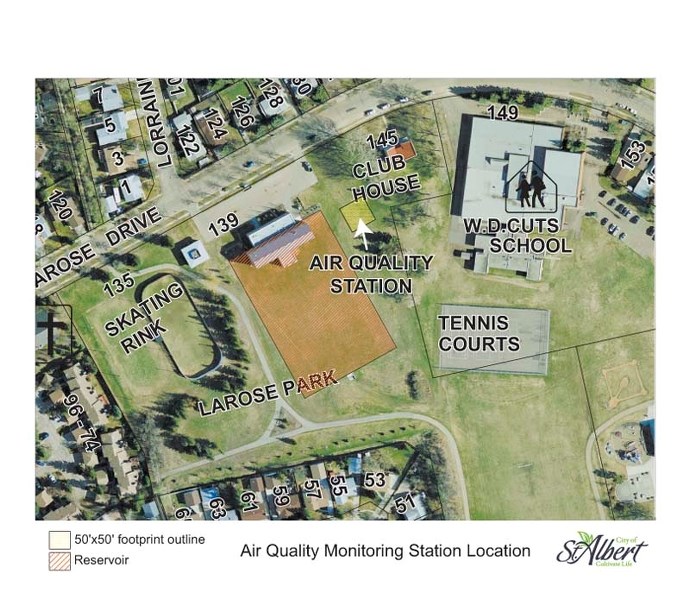The future of St. Albert’s air quality monitoring station is in doubt now that a local resident is challenging its proposed location.
St. Albert’s subdivision and development appeal board met Wednesday in council chambers to consider Charlene Berard’s appeal of a development permit for an air quality monitoring station in Larose Park. It immediately adjourned the matter for two weeks because it did not have quorum.
St. Albert learned last September that Alberta Environment had agreed to build a $250,000 air quality monitoring station in the city. If built, it will be the city’s first, and will provide residents with hourly reports on air pollution.
The station is a three-by-six metre building that resembles a utility trailer.
Alberta Environment chose to put the station next to the Lacombe Park Reservoir in Larose Park. The city applied for a development permit to build the site and informed all residents within a 30-meter radius.
Berard, who lives across the street from the proposed site, said she only learned of the station when she got a notice in the mail. “This came as a complete shock,” she said. “We just got slapped with this approval.”
Berard said the station would lower her property values and detract from public space in a park. “I have an open park right outside my window, and now I’m going to have a trailer with a chain-link fence around it.”
Several neighbours wrote letters to the appeal board supporting her position, including Gary Comber. “Kids are playing here every day,” he said. “To plop it down in a park … without notice, without consultation, without consent is not appropriate.”
About 176 people, many parents at nearby daycares, signed a petition circulated by Berard and her neighbours opposed to the station.
Berard and Comber argue that the station does not comply with the land use bylaw, as it had been classified as a “public utility building.” “It’s not a public utility building,” Berard said. “It’s a research and testing building.”
Research labs and research and development businesses are not allowed in public parks under the land use bylaw.
The bylaw also requires new developments to be compatible with neighbouring structures, Berard said. “A trailer is not consistent with any of the buildings on Larose Drive.”
She hoped the board would quash the development permit and that the station would be built elsewhere, such as by Fountain Park Pool. “St. Albert owns land elsewhere. Why does (the station) have to be put into a public park?”
Alberta Environment uses many rules to determine where it puts monitoring stations, said city community sustainability manager Leah Kongsrude. Stations need to be near power, accessible 24/7 and secure, and far from roads, valleys, forests and buildings that can skew readings.
The province narrowed its list down to Larose Park and Fountain Park Pool, Kongsrude said, with Larose winning as it had more consistent air readings. The roofs of local buildings in Larose were not available 24/7, while the field behind the reservoir building covered the reservoir itself – putting a building on it could damage it.
While the permit suggests that the station could take up a 15-by-15 metre square, Kongsrude said this was the maximum amount of room needed – it would likely be closer to 4.5 by 7.6 meters. The station could also be moved a bit to avoid areas used by local kids. “We do have some flexibility.”
The city planned to put a decorative wrap on the station and a residential-style black chain-link fence around it to improve its look, Kongsrude said. Shrubs and other screening were also options.
The city’s land use bylaw doesn’t cover air monitoring stations, said Jim Killoh, the city’s manager of development – the closest it comes is a public utility building, which is permitted in parks and defined as a system that provides a variety of services “for public consumption benefit, convenience or use.”
While “air monitoring” is not one of the listed services, Killoh said the city believes this station still provides a service (monitoring) for public benefit. It will be up to the board to decide if this interpretation is correct.
This station was publicized in the newspaper and through the Environmental Advisory Committee, Killoh said, when asked about consultation, and these developments don’t usually trigger an open house or public hearing. “It’s basically a 10’ by 20’ structure,” he said. “Does it warrant a public hearing or an open house?”
St. Albert is the only city in Alberta with more than 50,000 residents that doesn’t have an air quality monitoring station, Kongsrude said. This station will let residents know when the air outside is safe to breathe.
The city would have to look for a new site if this permit is stopped, Kongsrude said, and its options are few. “The worst case scenario is we wouldn’t get a station.”
The hearing resumes in council chambers at 6 p.m. this June 26.




